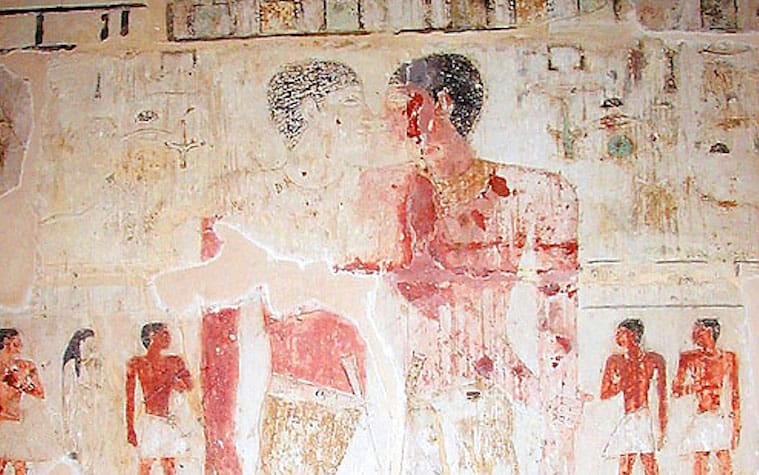By Lino DiNallo
Out Adventures is off to Egypt to cruise down the Nile riverboat-style. We’ll be spoiled like pharaohs and fed like gods while riding a water chariot through ancient history. But first we’ll spend a weekend in Cairo, Egypt’s 4,000YO capital. Among the pyramids we visit lies the necropolis Sakkara. It’s the world’s first limestone structure with an even juicier claim to fame: herein awaits the tomb of what may be the world’s first known same-sex couple, Khnumhotep and Niankhkhnum. Read on to savour this morsel of ancient queer history.
They were supporting stars of a dynasty.
Khnumhotep and Niankhkhnum were governors for King Nyuserre—sixth Pharaoh of the Fifth Dynasty, the era that gave us The Pyramid Texts. These prayers, inscribed on tombs, are the oldest religious documentation in the world. While it was the dawn of religion, Khnumhotep and Niankhkhnum had more frivolous pursuits. As royal confidants the men shared the title Overseers of the Manicurists of the Palace of the King. They literally supervised the royal nail salon. So camp.
Cliché as it sounds, running a beauty parlour isn’t why Egyptologists believe the men might be gay: sharing a tomb tells us they intended to spend the afterlife together. Historians determined both men were married to women and had children, but neither family is the focus of the tomb artwork. The men’s mutual bond is what was memorialized.
It was also common for different family members to be entombed together, but the artwork is intimate: the men hold hands, embrace, even rub noses (nose smooches were the era’s most intimate expression of affection).

Entrance to the second vestibule of the tomb, featuring Khnumhotep and Niankhkhnum 
Exterior of the tomb, or mastaba, from afar.
Joined in Life. Joined in Death.
Khnumhotep and Niankhkhnum weren’t the men’s birth names, but it was how the royal family referred to them and on their tomb. Depending on the translation, their names are literally, “Joined in life. Joined in death.”

Other theories about the relationship exist.
Egyptologists still aren’t in agreement Khnumhotep and Niankhkhnum were gay. Or in a bromance. They could be siblings, possibly twins, possibly conjoined. In fact one name for their tomb is The Tomb of the Two Brothers. There is further speculation that if they were siblings their parents were a noble couple named Khabaw-khufu and Rewedzawe.
Married. With kids.
As mentioned, both men had families. Khentikawes was Niankhkhnum’s wife. They had three sons named Hem-re, Qed-unas and Khnumhezewef, and three daughters named Hemet-re, Khewiten-re and Nebet. Khnumhotep married Khenut and sired five sons: Ptahshepses, Ptahneferkhu, Kaizebi, Khnumheswef and lastly Niankhkhnum (like his father’s partner). He also had a daughter named Rewedzawes.
On royal hand jobs.
Khnumhotep and Niankhkhnum’s team of manicurists formed one single facet of the pomp and circumstance that made the king sparkle for public appearances. His team was huge. A Keeper of the Headdress minded the royal wigs. A team of hairdressers would shave the king. Another Overseer—of the Two Chambers of King’s Adorners—supervised the women who helped him get dressed. It was a Kardashian-scale production of vanity.

Titularies For The Gods.
Though we can only speculate about Khnumhotep and Niankhkhnum’s relationship and/or how they became part of the royal court, we know where things stood when they died. The list of titularies bestowed on them (and inscribed on the tomb) is impressive. Along with overseeing the manicurists, they were also ‘guardians of secrets’, ‘beloved of his lord’ and ‘officially honoured before the great god by the lord’…this meant the king contributed handsomely to the cost of their mortuary. They were clearly valued members of his inner sanctum.
Different attitudes about male sexuality.
Today Egypt’s politics surrounding homosexuality are notorious, but you can learn more about why we still visit such countries here. Back in the day however marriage wasn’t about undying love and monogamy. It was about procreation and/or strategic alliances between families. Sex between men may not have been encouraged, but it certainly wasn’t taboo. In fact, it was often about domination, with the top being celebrated for virility.

More possible examples of BGWAG: Being Gay While Ancient Egyptian
Khnumhotep and Niankhkhnum don’t have exclusive claim to ancient Egypt’s homosexual shenanigans.
- The tale of Horus and Seth gets as graphic as Game of Thrones. In this myth about brothers vying for the throne, Seth tries to seduce—and specifically top—his nephew Horus for domination. Horus somehow cups his uncle’s ‘effluence’ and brings it to his mother, Isis. She then cuts off Horus’ hands and helps him discharge his own load. Finally Horus impregnates Uncle Seth by feeding him semen-covered lettuce.
- In the mystery-shrouded tale of King Neferkare and General Sisene from the Sixth Dynasty, some gay historians swear the two men are in a relationship, but major chunks of the story remain MIA.
- While they weren’t entombed together, some speculate there was a sexual connection between the 10th Ruler of the 18th Dynasty in the New Kingdom, Akhenaten and Smenkhkare his fellow king. This would make Akhenaten THE first known gay person. However, others believe Smenkhkare was really Akhenaten’s beautiful and famous wife Nefertiti in drag. Would that make her the first cross-dresser?
See the tomb for yourself
As this tomb may be the dawn of gay history, why not check it out yourself? Booking is now open for our Egypt: Nile River Cruise & Cairo trip. Click here for all the tour details including dates, prices and itinerary.
Photo credits
All photos of Wikipedia Commons.

Lino has been Out Adventures’ head writer for five years now. He’s now been on six trips with the company, and seen more of the world than he ever dreamed possible. Follow Lino on Instagram – @superfancystoryteller.
Featured Posts
For our first tour of Egypt in nearly a decade, we wanted to find accommodations fit for a pharaoh. Check out the luxe lodgings we settled on here. Read More
